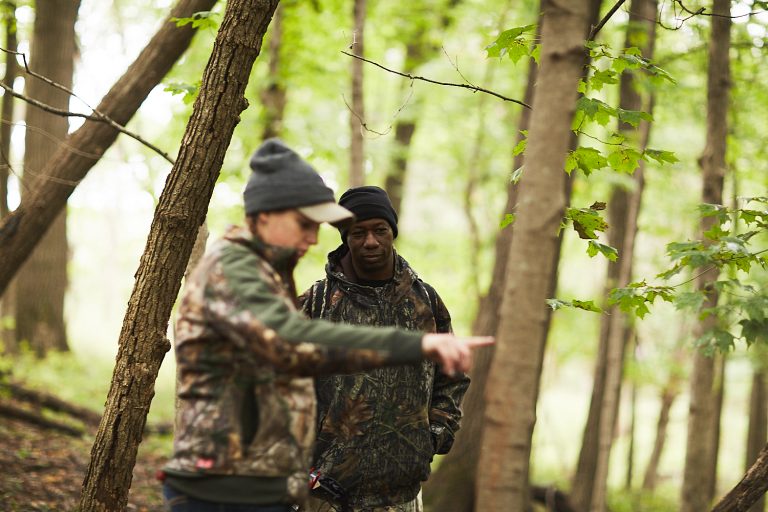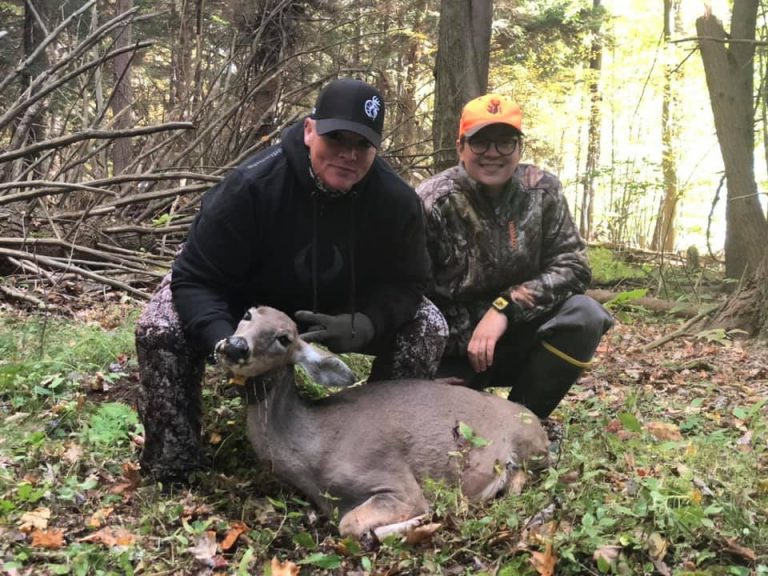Industry
Recruit Within Your Company to Grow Your Business, the Industry
Introduce your staff and team members to bowhunting with these tips and programs.
Photo Credit: QDMA
Do you know many nonhunters?
Of course you do! Without thinking hard, several people probably came to mind: your friend, distant cousin, dental hygienist, or perhaps someone in your immediate family.
According to the 2019 National Shooting Sports Foundation report, 84% of Americans approve of hunting for meat. But an Archery Trade Association survey found that only 4% of Americans 18 or older hunted with a bow in 2015.
That means the U.S. has millions of potential bowhunters. Perhaps more surprising, some of them are even employed in the industry.
Hank Forester, the hunting-heritage programs manager for the Quality Deer Management Association, regularly encounters people who work within the outdoor industry but were never introduced to archery or bowhunting.
“That should be shocking, but it’s not to me anymore,” he said. “I guarantee we’ll find it in most archery companies unless they’re running a program.”
Many companies hire people for their skills, personality and work ethic – not their interests. But what if your accountant, salesperson, bow technician, or marketing specialist was never introduced to archery? Maybe they’re interested, but they’re too intimidated to ask for help or start the adventure alone. Or, maybe they’re waiting for an invitation or opportunity to go.

Don't assume everyone on your staff has bowhunted. Photo Credit: QDMA
Forester said we’re overlooking opportunities to recruit new archery participants that are right in front of us, and that needs to change to grow the industry.
“We pass people every day that want to learn to hunt, including our colleagues and the people we’re around the most,” Forester said. “In an era of declining hunting participation, it’s every stakeholder’s duty to try to reverse or slow hunting decline in this country. We need to lead by example and give [company employees] the opportunity to experience what we hold dear.”
Educating your employees about archery and its many disciplines and providing an opportunity to get involved increases participation numbers, which in turn generates funds for nationwide conservation efforts through the Federal Aid in Wildlife Restoration Act (the Pittman-Robertson Act).
Plus, knowledgeable and experienced staff have the potential to help improve your business. Forester said people who understand and participate in archery sports become better advocates for hunting and the industry.
Sharing your passion for hunting is easy with the resources available from organization like ATA and QDMA. Let’s look at how one company introduced its staff to bowhunting through a Field to Fork class.
Jerry Tibbott and his son Austin own The Bearded Buck, an outdoor lifestyle and entertainment company in Pennsylvania. They’ve mentored beginner hunters for more than 10 years and recently partnered with QDMA to host a Field to Fork event for Traeger Grills’ employees and brand ambassadors.
“We’ve always mentored youths and adults to hunt, and as good and satisfying as that is, we’ve come to realize they’re usually not big influencers with a large reach and social following,” Jerry Tibbott said. “Those individuals pick up hunting, but the recruitment process usually stops there. We wanted to reach more people, and food is a giant pathway to acceptance, so we turned to our partner Traeger Grills.”
Traeger Grills’ employees were ecstatic about the opportunity. The Tibbotts worked with Tyler Stark, Traeger Grills’ director of marketing, who assembled four people within the company who had never hunted or had limited hunting experience. Two first-time participants were Remick Smothers, the outdoor marketing manager at Traeger Grills, and Danielle “Diva Q” Bennett, a brand ambassador with more than 400 BBQ and grilling awards, including multiple BBQ Pitmaster Grand Championships.
Both representatives participated in a three-day education class and a three-day crossbow hunt. Their experience was eye-opening, but the secondary results were jaw-dropping.

Danielle "Diva Q" Bennett, brand ambassador for Traeger Grills, loved her bowhunting experience. Photo Credit: Diva Q
Stark said Smothers now has first-hand knowledge about hunting and can speak more authentically about hunting’s benefits and the Traeger brand. Likewise, Bennett posted about her experience on social media and received tons of positive feedback from her followers, some saying they were inspired and hope to try bowhunting soon.
“The idea and concept of working within organizations in the outdoor industry must be better accepted and approached,” Tibbott said. “[Your coworkers] are people you take for granted every day. They might not be interested in hunting, but if you offer an opportunity to them, you’d be surprised by how they take it up.”
No matter your company size or how many nonhunting employees you have, you can create a learning opportunity or program so everyone on your team can participate. Be creative and open-minded. Consider offering one or more of these options to your staff, employees and partners.
- One-on-One Mentoring: A mentor helps guide a new hunter along their hunting pathway. They provide support and practical advice, and help beginners build skills, knowledge and confidence throughout their hunting journey. Mentors often form a strong bond and relationship with their mentees. The pair can easily coordinate schedules and participate in many bowhunting-related activities.
- Lunch and Learn Sessions: Gather staff and teach them about archery and bowhunting over lunch. Create a schedule and curriculum. Teaching participants in 30-minute windows helps them stay focused. It’s a great way to maximize time so that no one has to stay after work to get involved.
- A Day on the Range: Teach staff proper shooting techniques on a designated “Day on the Range” training. Help them become familiar with the equipment and get them excited for next-step opportunities, including bowhunting, bowfishing, or competitive archery. To take it a step further, help them become certified to teach archery.
- A Field to Fork Program: Host a Field to Fork program, which is a food-focused hunter-recruitment program for adults with nonhunting backgrounds. These events welcome newcomers to hunting while teaching them valuable hunting skills.
- Hunter Education Class: A hunter safety course teaches students about safety, hunting tactics, hunting laws, shot placement, blood trailing, field care, and equipment needs. Teach a class at your business, or partner with a hunter safety instructor to offer the class to your employees.

Host your own Field to Fork event, but don't push your employees to participate if they are not comfortable bowhunting yet. Photo credit: QDMA
Ready to start with programming at your workplace? Here are a few tips from our experts to ensure your efforts are productive and well-received:
“The key to success is to let [your staff] self-select,” Forester said. “Don’t nominate or push people into it.” Instead, ask them if they want to learn to hunt or shoot archery equipment. Having support, access to hunting land, or basic knowledge of hunting practices are barriers to participation. To share your passion, extend a personal invitation and offer to teach them about equipment, shooting form and hunting strategies. If they turn down your opportunity, respect their decision, but keep the invitation open if they change their mind.
“Find ways to make it more fun and interactive,” Stark said. “There is always a lecture component, but don’t submit your staff to hours of lectures.” Stark challenges people to give their staff hands-on experiences. “That will be a much better teacher than sitting through lectures or reading books,” he said. ATA members can use activities from the Explore Bowhunting curriculum for ideas. Log into your MyATA member dashboard and click “Download Free ATA Resources.”
“Stick with it,” Tibbott said. “It takes more than one hunt to make a hunter. I encourage mentors to stick with a beginner for two seasons.” The more support beginners receive when starting, the more likely they’ll stick with it. Each person is different, and the level and length of support will differ. Regardless, stay connected, answer their questions, demonstrate ethical behavior, and follow up with them often.
“Businesses don’t have to go about this themselves,” Tibbott said. He suggests working with private landowners, conservation groups, and trustworthy individual hunters. Partnering with other people, companies and organizations reduces your workload, which makes it easier to introduce more people to archery and bowhunting.
The ATA partnered with QDMA to create a free, comprehensive mentoring guidebook. The guide will debut at the 2020 ATA Trade Show in January and will be available for download on ATA’s Resource Website. Forester said ATA members can also access the QMDA’s educational resources, including beginner class curriculum, on its YouTube channel.
Introducing your staff to archery and bowhunting will improve their industry knowledge and help them do a more thorough job marketing and representing your business. Having a team that can understand, and connect and communicate with customers gives you an edge over your competitors.
As an added benefit, Forester said, “the water cooler talk in your office will be a lot more fun if you have employees hunting together and sharing knowledge.”
Opportunities exist all around you. Once you’ve introduced everyone you know to archery sports, expand your search. Use these tips to attract youth archers. Or, read this article to learn how to recruit racially diverse archers.
For questions or more information about creating programs for your staff and customers, contact Nicole Nash, ATA’s range and retail programs manager, at nicolenash@archerytrade.org.

WE ARE HERE TO HELP THE INDUSTRY, TO HELP INDIVIDUAL BUSINESSES GET THE MOST OUT OF THE INDUSTRY, AND TO HELP YOU.